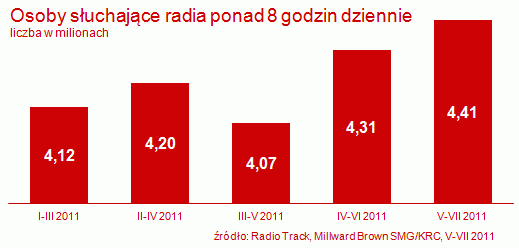
More than half of these listeners, whom Radio Track calls heavy users, have a secondary education, more than double the next group of listeners with higher education.
Breakdown of Radio "Heavy Users" by Education Level
- Secondary - 51.2%
- Higher - 23.3%
- Vocational - 17.8%
- Primary - 7.6%
According to Radio Track, among those spending more than 6 hours with the radio, there is a higher proportion of white-collar workers than in the general population - they make up 22.1% of these listeners. There are also more business owners (10.9%), directors and professionals (14.8%), and skilled laborers (22.4%).
These data are significant due to the advertising potential. It’s no surprise they’re often highlighted, as in a recent release by the Radio Research Committee, which emphasized that company heads listen to their favorite stations more than average.
The listeners who spend the most time with the radio are primarily adults: people aged 25-39 make up 37.8% (significantly more than 29.3% of all respondents), and those aged 40-59 account for 39.3% (compared to 35.7% of all respondents).
It’s worth noting that the increase in people who keep their radios on for long periods may be influenced by the summer season, when Poles traditionally listen to the radio longer and more often. Additionally, programming and music changes are increasingly tailored to meet audience expectations and needs.
COMMERCIAL BREAK
New articles in section Media industry
Advertising market 2025. Poland, Europe and the World
Marcin Grządka
The global advertising market is growing by 8.8% in 2025 and will reach a value of 1.14 trillion dollars. The industry result in Europe records slightly lower dynamics, at the level of 5.8%. In this comparison, Poland performs clearly above the average. We will record an increase of 8.9% this year and a value of 18.56 billion PLN - estimates WPP Media in the annual report "This Year Next Year".
The print media market 2025. Three global trends
Krzysztof Fiedorek
The market value is 359.53 billion dollars, yet the erosion is visible to the naked eye. The decline for newspapers will amount to -2.3 percent. Despite this, print retains strength: it generates 76 percent of subscription revenues and enjoys 82 percent consumer trust. The future of the industry is defined by hybrid strategies and niche specialization.
Journalism in the age of AI. Why people prefer humans over machines
Krzysztof Fiedorek
Only 12% of people accept news created solely by AI, while 62% prefer those written by humans. At the same time, only 19% notice labels indicating the use of artificial intelligence, while younger audiences ask AI to explain the content to them. These are the findings of the Reuters Institute report on artificial intelligence in media.
See articles on a similar topic:
"No One Should Know the Truth" [DOCUMENTARY FILM]
BARD
According to the Belarusian Association of Journalists, around 554 journalist detentions occurred in Belarus between August 2020 and July 2023. Criminal charges were brought against 73 media workers, and 33 of them remain in prison to this day.
First Trillion Dollars. Advertising Market 2024 and Forecasts for 2025
DUG
GroupM, in its cyclical report "This Year Next Year," summarizing the past year and predicting trends for the next, has published the latest forecasts for global advertising markets. The estimated advertising market growth rate in 2024 is as high as 9.5%, bringing its value globally to over 1 trillion dollars.
Algorithmic personalization study. Who and how understands digital media
KFi
Most internet users believe that everyone sees the same content online. Meanwhile, algorithms personalize messages so effectively that a young woman with higher education receives different information than her father. Researchers reveal who truly understands the mechanisms.
Fake News in Poland. Challenges in Assessing Information Credibility
RINF
One in four information consumers relies on sources where verifying credibility is a significant challenge. Fake news remains a major issue, as indicated by 77% of respondents, with 51% admitting they struggle to discern truth from falsehood, according to Deloitte's *Digital Consumer Trends 2021* report.






























